|
Amazon gold
An international, boots-on-the-ground research project known as the Andes to Amazon Biodiversity Program is taking TCU students to remote rainforests in Peru, where they dodge myriad dangers while studying exotic species like stinky mushrooms and deceitful orchids. The goal: Save the rainforest.
By Nancy Allison
Photography courtesy BRIT

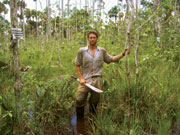 Romina Gazis ’07 (MS) tries to remember to look up, in case there are flags. Looking up is good: sometimes flags on the trail signal jaguar traps. But Gazis is a mushroom hunter, so she’s always looking down. She isn’t afraid. Not of jaguars, anyhow. Or of poisonous ants and spiders, or the huge anaconda that sleeps by the pond. Only the wild pigs give her pause. Especially when they trot past, 20 to 30 in a pack, their curved tusks gleaming. Romina Gazis ’07 (MS) tries to remember to look up, in case there are flags. Looking up is good: sometimes flags on the trail signal jaguar traps. But Gazis is a mushroom hunter, so she’s always looking down. She isn’t afraid. Not of jaguars, anyhow. Or of poisonous ants and spiders, or the huge anaconda that sleeps by the pond. Only the wild pigs give her pause. Especially when they trot past, 20 to 30 in a pack, their curved tusks gleaming.
It’s hard to picture Gazis wielding a machete. Sweet-faced and smiling in a summer dress and heels, she explains her award-winning poster on fungi at TCU’s research symposium with quiet enthusiasm. But as one of the first recruits in an exciting collaborative research project in the Amazon, Gazis knows how to handle a long knife.
“The work in the lab back at TCU is the hard part,” said Gazis, after a long day slogging at her thesis project, a field guide to tropical fungi. Identifying and writing about the mushrooms she’s collected, now shriveled and brown like dry twigs, is tough. “Being out in the forest, finding and photographing fungi, that’s the reward.”
Andes to Amazon Biodiversity Program (AABP)
The AABP is an international, multidisciplinary team of scientists, students and Peruvian locals working through the Botanical Research Institute of Texas (BRIT) in selected field and museum sites in Peru.
The team works closely with scientists from the World Wildlife Fund, the New York Botanical Garden and the Amazon Conservation Organization, as well as Peruvian student researchers from the San Marcos Herbarium and La Molina University.
TCU’s Institute for Environmental Studies is a partner with BRIT through the AABP, providing faculty and students for research. Graduate students receive singular field experience through this partnership. |
FAR FROM LIFE in the Amazon is a restored warehouse in Fort Worth that seems to hum with the heartbeat of the planet. Samples of nearly all of Earth’s known plant families reside here on Pecan Street, at the Botanical Research Institute of Texas (BRIT). Properly known as an herbarium, this museum of once-living plants spans centuries and continents, genera and species. Botanists, students, and researchers come here from all over the world to study the more than 1 million dried plant specimens shelved in the vast cupboards that line BRIT’s old wooden floors.
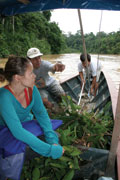 Tiana Franklin ’07 (MS), reading her way through every specimen of a certain Neotropical tree, notes that the hum in the room is only the cooling system, keeping the air at the proper humidity for dried plants. Franklin is studying the genus Virola, a member of the nutmeg family Myristicaceae (pronounced mris-tih-cay-cee-ee), prolific in the Amazon. She points to the tiny flowers of Virola on one of the specimen sheets. It’s difficult to see inside the minuscule dried petals. So she turns to a laptop on one of the long oak tables and logs into Atrium, the new BRIT-built database of information on the Amazonian rainforest. (See side bar below) Tiana Franklin ’07 (MS), reading her way through every specimen of a certain Neotropical tree, notes that the hum in the room is only the cooling system, keeping the air at the proper humidity for dried plants. Franklin is studying the genus Virola, a member of the nutmeg family Myristicaceae (pronounced mris-tih-cay-cee-ee), prolific in the Amazon. She points to the tiny flowers of Virola on one of the specimen sheets. It’s difficult to see inside the minuscule dried petals. So she turns to a laptop on one of the long oak tables and logs into Atrium, the new BRIT-built database of information on the Amazonian rainforest. (See side bar below)
In Atrium’s virtual herbarium, Franklin locates an image of a Virola flower cluster, one of hundreds she has photographed herself. Each time she taps the mouse, the picture resolves into more detail. A feature of the zoom and pan function that is part of the program, it’s a wild ride straight into Virola’s heart.
Click, and you whip from a view of a dozen flowers to one. Click, now you’re on the edge of the bloom’s opening, with a bee’s-eye view of its sticky anatomy. One more click and you’re so deeply into the flower that you might brush imaginary pollen from your nose.
“This one’s male,” Franklin claims, and who can doubt her? She’s the resident gender-checker of the wild nutmeg. With help from assistant TCU biology Professor Ernest Couch and the scanning electron microscope in TCU’s lab, she has determined the reproductive characteristics of thousands of specimens. But this is just one part of Franklin’s research. The other involves “tracking” Myristicaceae trees using GIS, the geospatial information system that allows her to pinpoint the location of every wild nutmeg tree she can find — and put it on a digital map.
In the last year in Peru, Franklin and several Peruvian field assistants counted more than 10,000 Myristi-caceae trees growing on approximately 88.5 acres. They recorded the diameter, height, species name and fruit or flowering status of each tree. Franklin’s research, available on Atrium’s GIS pages, seems to confirm that the Myristicaceae is one of the top five most abundant tree families in the Madre de Dios area of the Amazon.
 The numbers suggest that the wild nutmeg is a key part of the ecosystem, which includes the birds and monkeys who feed on its fruit. The numbers suggest that the wild nutmeg is a key part of the ecosystem, which includes the birds and monkeys who feed on its fruit.
Why do the numbers matter? “Under-neath the policy that effects change is the science that makes that policy possible,” Franklin said. In the battle against human encroachment (a highway being built not far away and the hunters, gold miners and mahogany poachers who threaten to impinge on this pristine area), hard and fast data is the scientist’s only weapon.
Yet it’s obvious that Franklin is not only a scientist, but also a tree-lover, and partial to Virola’s creamy flowers and lemon-lime scent. “You should see them in the wild,” she says with a wistful grin. Of course, that would require a flight to Peru, a five-hour boat ride to the jungle, and a perilous climb up an eleven-story-tall tree. To Franklin, that’s one of the best perks of the job.
And what a crucial job it is. Abundant rainfall, year-round warmth, and the remoteness of the terrain combine to make tropical rain forests incredibly rich in species. They cover only 7 percent of the world’s surface, but, like a fairy-tale beard on the earth’s chin, abound in a fantastic array of living creatures. Home to as many as two-thirds of the species of animals and plants that exist, tropical forests are both the most diverse and the most threatened areas on Earth.
Conservationists refer to such regions as biodiversity hot spots, places most urgently in need of protection and study. In 2001, one such biodiversity hot spot — Los Amigos — was granted the first private conservation concession in the world.
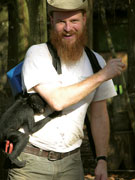 John John
Janovec
Director
of the AABP;
BRIT research
scientist;
TCU adjunct faculty
|
|
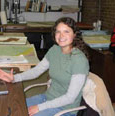 Keri Keri
McNew
’01, MS ’04
BRIT project
manager |
|
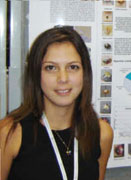 Romina Romina
Gazis
MS ’07
Special area of research: fungi
|
|
 Tiana Tiana
Franklin
MS ’07; BRIT research assistant
Special area of research:
wild nutmeg tree
|
|
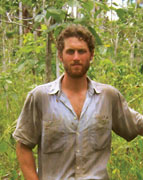 Ethan Householder Ethan Householder
’03; MS ’07
Special area of research: vanilla orchids |
|
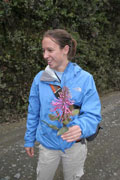 Rebecca Repasky Rebecca Repasky
‘04; MS ’07
Special area of research: orchids
|
|
Other Horned Frogs involved:
Andrew Waltke ’06
graduate student
Jorge Lingán
graduate student
Suresh Kanal
’06; GIS consultant for AAPB
Andrew Reina ’06
Thesis committee members:
Ranjan Muttiah PhD
Director of TCU’s Center for GIS and Remote Sensing which contracts with AABP
Ernest Couch PhD
John Horner PhD
John Pinder PhD |
|
LOS AMIGOS, a 360,000-acre wilderness in the lowlands of the Madre de 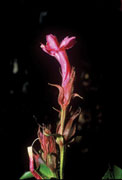 Dios River basin in southeastern Peru, was once a rubber tree plantation, then a gold-mining camp. Populated by spider monkeys, macaws, giant otters, jaguars, pumas, wild pigs, snakes, parrots and other animals, Los Amigos is now a scientific research station leased by the Amazon Conservation Association of Washington, D.C., and its Peruvian partner, ACCA. Dios River basin in southeastern Peru, was once a rubber tree plantation, then a gold-mining camp. Populated by spider monkeys, macaws, giant otters, jaguars, pumas, wild pigs, snakes, parrots and other animals, Los Amigos is now a scientific research station leased by the Amazon Conservation Association of Washington, D.C., and its Peruvian partner, ACCA.
The station, which includes a system of trails, cabins, a cafeteria, and even a small herbarium, is home to international researchers and projects throughout the year. And where Gazis, Franklin and four other TCU graduate students, a team of Peruvian field assistants and a passionate TCU/BRIT botanist, come to study everything from hawk moths to tapirs to vanilla orchids — and combine their findings in a revolutionary new way.
Actually, Alexander von Humboldt, one of the first Amazonian explorers, suggested such visionary biology 200 years ago: a science of connections, the study of all natural phenomena and interaction, a holistic, interdisciplinary approach to understanding the earth over time. But the scientific community ignored von Humboldt’s plea for comprehensive biology. Research has been conducted in isolation, for the most part, with scientists concentrating on their own fragmentary studies, ever since.
 Enter John Janovec: Kansas farm boy, von Humboldt fan, Amazonian explorer and botanist. In 2001, as a postdoctoral researcher at the New York Botanical Garden, he became involved in a research project in Peru. While in New York, he and then-wife Amanda Neill, a doctoral fellow, developed the idea for a website called Botany Pages, a searchable database of the flora of the area. It was then that Janovec saw the value in applying multiple approaches to his work. Enter John Janovec: Kansas farm boy, von Humboldt fan, Amazonian explorer and botanist. In 2001, as a postdoctoral researcher at the New York Botanical Garden, he became involved in a research project in Peru. While in New York, he and then-wife Amanda Neill, a doctoral fellow, developed the idea for a website called Botany Pages, a searchable database of the flora of the area. It was then that Janovec saw the value in applying multiple approaches to his work.
“I began to mix methods of traditional taxonomic investigation, GIS mapping of species and spatial analysis of distribution, as well as DNA sequencing and analysis for systematic, evolutionary, biogeographic, and population genetics of species of the Myristicaceae,” he said.
Translation? Janovec was attempting a 21st century von Humboldt: the kind of integrative science that would have far-reaching implications for his next project. He just didn’t know it then.
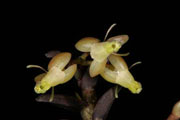 While at Los Amigos, Janovec met a representative of the Gordon and Betty Moore Foundation, a private grant-making organization that sponsors environmental research. Although he was happy with the work in Peru, it was difficult living from grant to grant. So when BRIT recruited Neill as the new head of botanical information and collections of the herbarium in 2003, the young couple jumped at the chance to move to Fort Worth. BRIT then hired Janovec as a research botanist. While at Los Amigos, Janovec met a representative of the Gordon and Betty Moore Foundation, a private grant-making organization that sponsors environmental research. Although he was happy with the work in Peru, it was difficult living from grant to grant. So when BRIT recruited Neill as the new head of botanical information and collections of the herbarium in 2003, the young couple jumped at the chance to move to Fort Worth. BRIT then hired Janovec as a research botanist.
“It was really Amanda they were after,” he said. But it was a “two-for-one” that BRIT wouldn’t regret.
Not long after moving to Fort Worth, the Moore Foundation representative encouraged Janovec to write a proposal for funds to continue the interdisciplinary rainforest research he, Neill and Fernando Cornejo had begun in Peru. With the help of Mathias Tobler, a Swiss research scientist Janovec met through a GIS listserve, the four colleagues put their heads together and described the work they wanted to do in the Amazon.
In 2003 the Moore Foundation awarded BRIT a $2.3 million challenge grant for the Andes to Amazon Biodiversity Program (AABP).
A REQUIREMENT of the Moore Foundation grant was a commitment to education. Which made it the perfect opportunity to introduce TCU students into a BRIT program — something Sy Sohmer, BRIT director, and Mike McCracken, dean of the College of Science and Engineering, had talked about for several years.
“It’s an excellent alliance,” McCracken said. “The scope of the research goes far beyond what a typical master’s student experiences in the field. Our students work some distance from civilization, in fairly primitive conditions. I admire them tremendously for their dedication.”
Sohmer points out that the students are participating in research that will likely serve as a model for standardized approaches and activities in other conservation areas of the world, hinting at the AABP’s long-term global implications.
Janovec, who is a TCU adjunct professor in biology, serves as the link between the 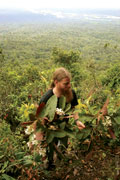 two, not only guiding students in the field, but also acting as thesis advisor and mentor. He’s often singled out as the poster boy for the AABP, a role he admits he doesn’t relish. But when you hardly sleep because there’s too much work to be done, live in boats and bivouacs in a race to cover as much of the forest and identify as many plants as possible before they disappear, talk about new projects at breakneck speed and then push them through as if there will never be enough time to do everything you envision — you’re going to get noticed. two, not only guiding students in the field, but also acting as thesis advisor and mentor. He’s often singled out as the poster boy for the AABP, a role he admits he doesn’t relish. But when you hardly sleep because there’s too much work to be done, live in boats and bivouacs in a race to cover as much of the forest and identify as many plants as possible before they disappear, talk about new projects at breakneck speed and then push them through as if there will never be enough time to do everything you envision — you’re going to get noticed.
Especially when others knowledgeable about the project say that it wouldn’t work without you; that your enthusiasm for it and for the team keeps it all going; that you’re a visionary. But Janovec is emphatic that the AABP works because of team effort, “each person focusing on their part of the project, all with an essential part to play.”
He prefers to turn the spotlight on others, such as Keri McNew ’01, MS ’04, the AABP project manager, who began her career at BRIT as a volunteer. “Keri pays all the bills, keeps track of what everyone is owed and should be paid both here and in Peru, gets us on flights, keeps us on schedule, and just generally makes things work — on a shoestring budget. Now she’s indispensable.”
Rainforest Education
The numbers suggest that the wild nutmeg is a key part of the ecosystem, which includes the birds and monkeys who feed on its fruit.
Why do the numbers matter? “Under-neath the policy that effects change is the science that makes that policy possible,” Franklin said. In the battle against human encroachment (a highway being built not far away and the hunters, gold miners and mahogany poachers who threaten to impinge on this pristine area), hard and fast data is the scientist’s only weapon.
Yet it’s obvious that Franklin is not only a scientist, but also a tree-lover, and partial to Virola’s creamy flowers and lemon-lime scent. “You should see them in the wild,” she says with a wistful grin. Of course, that would require a flight to Peru, a five-hour boat ride to the jungle, and a perilous climb up an eleven-story-tall tree. To Franklin, that’s one of the best perks of the job.
And what a crucial job it is. Abundant rainfall, year-round warmth, and the remoteness of the terrain combine to make tropical rain forests incredibly rich in species. They cover only 7 percent of the world’s surface, but, like a fairy-tale beard on the earth’s chin, abound in a fantastic array of living creatures. Home to as many as two-thirds of the species of animals and plants that exist, tropical forests are both the most diverse and the most threatened areas on Earth.
Conservationists refer to such regions as biodiversity hot spots, places most urgently in need of protection and study. In 2001, one such biodiversity hot spot — Los Amigos — was granted the first private conservation concession in the world. |
REBECCA REPASKY ’04 (MS ’07) understands the work is important on a global scale, but that’s not what kept her slogging through jungle perils.
“Every single day was an adventure,” she said, referring to the year she spent studying orchids in the high cloud forest of the Andes.
On her first day, she fell in love with the place. Wayqecha, at 2,900 meters (9,515 feet) high, is a sea of cloud-kissed trees. At 175 km (108 miles) from the Los Amigos station down in the lowlands, it is a gloriously beautiful, tremendously isolated place.
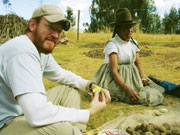 Glory aside, Repasky’s new home was a rudimentary shack. It housed two Peruvian field assistants, the wife of one of the two men, and Repasky. As the single woman she got the only room with a door; there was no electricity or indoor toilet. Glory aside, Repasky’s new home was a rudimentary shack. It housed two Peruvian field assistants, the wife of one of the two men, and Repasky. As the single woman she got the only room with a door; there was no electricity or indoor toilet.
At first it was a bit of a shock. “You say to yourself, ‘Well, suck it up and survive or go home.’ I didn’t want to go home, so I managed.” Repasky and Peruvian assistant Martin Ccana hiked year-round into forest collecting sites, and eventually found a whopping 250 species of orchids in 800 hectares (1,977 acres).
Repasky found something else as well: friendship with her Peruvian colleagues that transcended the barriers of language. “I miss the people and the pace of life there. Some days, we got up early just to watch the sun rise.”
Wayqecha, with the imminent threat of a road nearby, seems especially vulnerable to change. But, Repasky said, echoing the hope of the whole project, “orchids are huge indicators of biodiversity, and the fact that so many exist on the site may help to persuade the government to increase the concession.”
Repasky’s collections, many of them already verified by orchid expert Eric Christenson, number 401, including 3,327 images posted on Atrium’s online herbarium. But she also made another discovery that surprised scientists: there isn't “one” season for timing and frequency of flowering. It occurs year-round.
Repasky’s favorite species is the Telipogon, whose visual characteristics fool male insects into thinking they have discovered a mate. A highly specialized function called sexual deceit, it is a very effective means of increasing the Telipogon population by tricking pollinators into action.
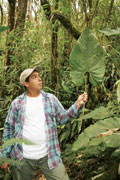 THE VANILLA orchid could do with a few tricks to help ensure pollination. In the black-water palm swamps back at Los Amigos, Ethan Householder ’03 (MS ’07), took bee-work into his own hands. Another of the AABP’s initial recruits, he lived in the swamps for a year to study the ecology of vanilla orchids and map their incidence. THE VANILLA orchid could do with a few tricks to help ensure pollination. In the black-water palm swamps back at Los Amigos, Ethan Householder ’03 (MS ’07), took bee-work into his own hands. Another of the AABP’s initial recruits, he lived in the swamps for a year to study the ecology of vanilla orchids and map their incidence.
An outgrowth of Householder’s research (and consistent with AABP’s goal of community education and production of non-timber forest products) has been to discover that the orchids, notoriously infrequent fruit-producers, could be hand-pollinated in the wild.
It was painstaking and slow, but successful. Householder and several field assistants hand-pollinated and eventually harvested and cured over 500 beans. The going rate for vanilla bean pods is $500 per kilo.
“One of the most outstanding ironies we saw every day is that while locals literally dig up these fragile swamps looking for gold beneath them, the real gold lies in the little fragrant fruits hanging from a vanilla orchid above their heads,” he said. “The goal eventually will be to find a way to harvest this vanilla sustainably, create markets for it, and thus provide economic incentive to conserve this precious swamp ecosystem. Conservation that pays for itself.”
Some would say that Householder paid dearly for his own dedication to conservation: last year he contracted Leishmaniasis, a flesh-eating disease spread by the sand fly. After finding a wound on his leg that wouldn’t heal, he was diagnosed with the sometimes-fatal infection. Daily injections of antimony (a heavy metal that in high doses can cause its own health problems) for one month were required to clear his system. Yet there’s no question where Householder feels happiest, nor what he hopes to do after he completes his graduate degree: “I want to get back to the palm swamps.”
Gazis, too, feels happiest reaching under logs and into dark places in the rainforest of her native Peru. She’s especially fond of the mushrooms that lure unsuspecting insects: one, a deceptively beautiful member of the stinkhorn family, smells like rotten meat, drawing flies to it to disperse its spores. Another colonizes the bodies of insects, sending spores inside them while they’re alive and feeding on them as they die.
Kind of gruesome, isn’t it? Not at all. “Fungi are the keystone species of the forest, breaking down molecules so that nutrients will be available to plants and the whole cycle can begin again. There’s one with a lacy cap called the bride’s veil. Ah, it’s so beautiful. Have you seen it?”
Thanks to the work of these adventurous students and the AABP, perhaps it will be around for a while yet, and we, and maybe even our children, will get the chance.
Comment about this story at tcumagazine@tcu.edu.
Contact Janovec at jjanovec@brit.org.
Learn more:
Andes to Amazon Biodiversity Program: www.andesamazon.org
Atrium: atrium.andesamazon.org
Botanical Research Institute of Texas: www.brit.org
Amazon Conservation Association: www.amazonconservation.org
The Moore Foundation: www.moore.org
Institute for Environmental Studies: www.ensc.tcu.edu

Inside ATRIUM
The word “atrium” comes from Latin, meaning large open space or chamber. In architecture, as in the human heart, it’s a space that allows for flow and connection. Jason Best, a soft-spoken biologist with a background in graphic design, is the AABP’s IT and production manager. As liaison between the scientists in the field and the two computer programmers of Atrium, the AABP’s web-based biodiversity information system, it’s Best’s job to ensure that online connections work and flow can occur.
On his laptop at BRIT headquarters, Best demonstrates the three main areas of the site:
• Botanical data — virtual herbarium of plant specimens, including both scientific and common plant name, who collected it and where, and “zoomable” images of the plant
• Bibliographic data — a searchable record of all books, journal articles and papers written in English and Spanish relating to biology and conservation in the Madre de Dios department of Peru
• GIS data — a repository of raster and vector files (pictorial representations of data) which can be searched and downloaded for use in GIS applications
Best points to the annotation feature on Atrium’s botanical data pages, a function that makes the program truly collaborative. “Users with special permission can edit botanical information — for instance, plant names — if they believe the specimen has been wrongly identified. This is a streamlined version of what a herbarium does: sending out specimens to experts all over the world for positive identification.”
This way, plants can be identified online weeks before the physical specimen even gets to the expert. Doing science faster and better is crucial in the race to save the rainforest. AABP fieldwork, while duly reported in printed journals for specialists, in not restriced to languishing in library stacks. With Atrium, results can be published online and shared with scientists around the world with an immediacy unknown in the past.
This means that researchers can work together to produce a shared, up-to-the-minute picture accessible by colleagues all over the world. In the GIS data section, soil maps can be laid over vegetation maps or hydrology maps to compare data and “see” the area in a more comprehensive way.
Identifying spatial trends and predicting the density of plants to assess economic value may help convince locals to consider wetlands worth saving, said Ranjan Muttiah, Director of the GIS and Remote Sensing Lab at TCU. Muttiah works with graduate students Ethan Householder ’03 (MS ’07) and Tiana Franklin (MA ’07) on the statistical analysis of the GIS data they collect in the field. He calls the rainforest a challenging environment, with no ready access to rivers and trails.
“You need an overall view of the area as well as a specific view: both the forests and trees, so that the relationships between plants, animals and terrain in this complex ecosystem can be understood, and preservation can be encouraged.”

Q & A with Scott A. Mori
Consultant to the Andes to Amazon Biodiversity Program, director of the Institute of Systematic Botany and Nathaniel Lord Britton Curator of Botany at The New York Botanical Garden.
Why is it important to study the rainforest?
Rain forests are home to nearly two-thirds of the biodiversity of the planet and provide ecosystem services such as protecting watersheds and climate both locally and globally. The first step in conservation of rain forests is to know the names of the fungi, plants, and animals found there as well as understand their interactions, and this is what the AABP team is doing.
How does the biodiversity of the rainforest affect those of us far from it?
All parts of the world are integrated into a vast biosphere that operates as a whole. If one ecosystem is destroyed it can have a negative impact on ecosystems throughout the world. For example, the Amazon holds a vast reservoir of carbon in its leaves, roots, trunks, animals, fungi, etc. and when the forest is destroyed this carbon is released into the atmosphere thereby contributing to the greenhouse effect and the warming of the world.
How would you characterize the Los Amigos center in Peru?
The Los Amigos Center provides the facilities to carry out research in the Amazon and is a place where professional biologists of all disciplines can work together to explore the diversity of Amazon forests and the biocomplexity of the most complicated ecosystem of the world. It is also a center for training the next generation to manage rain forests.
Can you describe what it's like to work with John Janovec?
John spent time at The New York Botanical Garden as a post-doc with me and our interaction stimulated me to present my data about my research directly from a database onto the Internet. This was a very important change to my career, and I know that he has had a similar impact on the careers of others. His ability to raise the money for the AABP and give a very productive return on the investment is a model that all researchers should follow. John is already a force in the community of systematic botanists and in rainforest conservation, and I predict he will become even more so with the passage of time.
|



